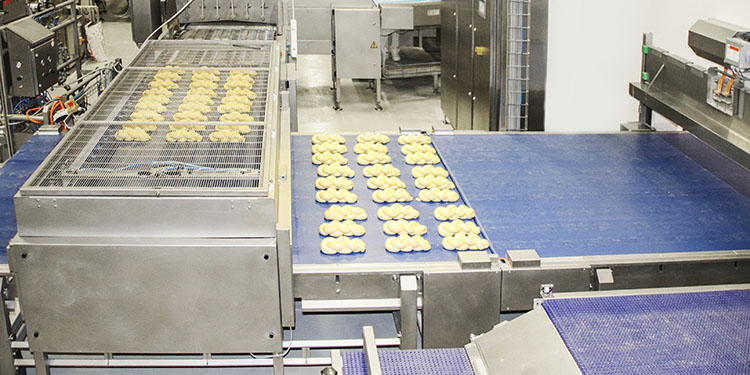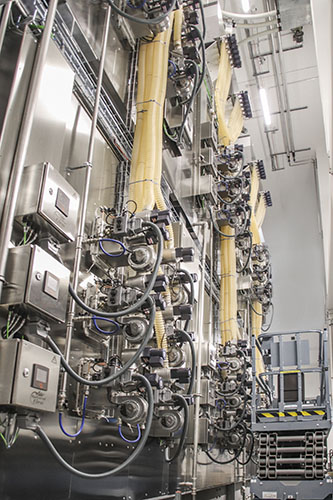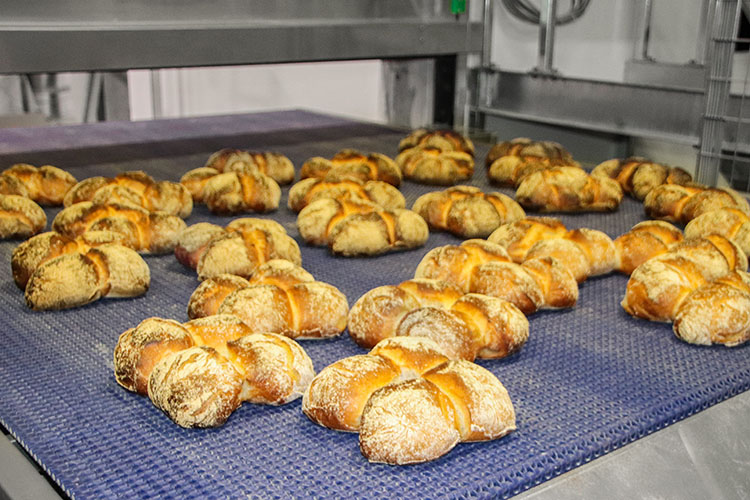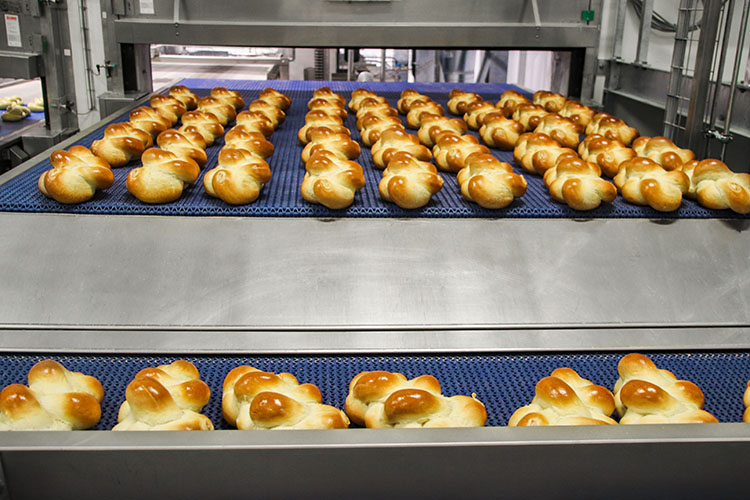
New wood-fired oven baking plant for Coop -Wood-baked bread is right on trend – particularly for Coop customers in Switzerland.
In order to meet the continually increasing demand for rustic, strongly baked breads with their unique taste, the Swiss cooperative is investing in the modernization and expansion of its bakery locations. Werner & Pfleiderer Lebensmitteltechnik was awarded the contract to build a fully automatic direct-fired oven system which included overcoming the special challenges presented by the structural conditions at the Coop site in Castione in Ticino, southern Switzerland.
In its own bakeries, Coop combines high craftsmanship in baking with state-of-the-art baking technology to produce a wide range of high-quality baked goods. When the retailer reorganized its production, it also set high quality standards for the technical equipment and assigned Werner & Pfleiderer Lebensmitteltechnik to plan, build and commission a fully automatic direct-fired oven system. This consists of 18 floor decks of the WP PELLADOR series including the necessary loading and transport technology. It is the second plant owned by Coop and the largest of its kind that WP has ever built. The plant manufacturer from Dinkelsbühl in Central Franconia specializes in oven technology for the baking industry.
A height of nine meters demands special construction
In addition to the enormous capacity of the plant, which has a baking area of 65 m2, the design engineers at WP faced a special challenge: the structural conditions. The bakery is located on the first floor of the production hall and the existing structural analysis was not designed for the weight of the massive ovens. A new extension on the ground floor was the solution, but it had to be implemented to the highest standards. The baking technology in the new building had to be connected to the dough preparation with a mobile loading system over two floors with a total height of nine meters, which is also separated by a fire protection wall. This was made possible by a special design of the WP OBER Pro deck oven loader, which has been on the worldwide market since 1992.
“We had a clear idea of the capacity, the limited space requirements and the special specification of the wood-fired oven baking system which would be required for more than 20 specialties such as organic wholemeal bread and the organic butter plait. The WP team, consisting of engineers, automation technicians and master bakers in the factory and on-site, supported us at all times with advice and practical assistance. As a result, we received a plant that exactly met our requirements, which went into operation on schedule in February 2020 and has been running to our complete satisfaction ever since,” concludes Simon Oeschger, head of the technical department and responsible for project coordination at Coop.

The wood oven baking system consists of 18 decks of the WP PELLADOR series including the necessary loading and transport technology

The baking technology located in the new building had to be connected to the dough preparation system with a mobile loading system over two floors with a total height of nine meters

Fully automatic loading from the bakery into the wood-burning oven baking system located in the new addition

Rear view of the plant with pellet burners, control and automatic pellet feeding system
Fully automatic system saves operators’ time
WP has further developed the principle of the traditional wood-fired oven, in which the baking chamber is directly fired with wooden pellets, into an ultra-modern system with wood pellet burners, which enables CO2-neutral firing and rational processes in the bakeries. “The Wood Baking WP PELLADOR production deck ovens are fired with modern, energy-saving industrial burners, each floor being equipped with two PLC-controlled pellet burners. The combustion of the pellets is largely residue-free and any combustion residues – the ashes – are also removed by a special suction device before each charging process. Baking is done in the classic way with falling temperature, whereby the individual recipe and product management and the oven and loader control is carried out via the integrated SIEMENS S7 overall system control,” explains Dr. Christoph Adams, Technical Director at WP. The system knows the status of each product in the baking process, including the baking time, and controls all processes fully automatically. This means that the operator only needs to monitor the system creating time for other tasks.
The system is fed with proofed dough pieces, which are placed on plastic peel boards in rack trolleys. At present, almost 100 peel boards are used per hour, which are loaded with up to twelve dough pieces depending on the product. In an automatic transfer system, they are “scrabbled off” from the peel boards in one go and fed to the deck oven loading system. In terms of weight, the system also allows conventional manual loading for special products such as the 3 kg butter plait. At the end of the baking time, the loader system moves to the corresponding deck for baking, unloads the baking chamber and transports the finished baked products to the downstream cooling system.


Coop uses the wood-fired oven baking system for the Swiss Bürli and their special butter plait, amongst other things
Wood oven bread from the WP Pellador meets all criteria
Baking in a wood-fired oven is a traditional technique. So what exactly is meant by the term, a wood-fired oven? The “Guidelines for Bread and Small Baked Goods of the German Food Book” from Jan 1994 describes it as being where, “wood-fired bread is pushed free and produced in directly fired ovens, with the baking chambers made of stone or a stone-like material. The heating material is located in the baking chamber. Only natural wood is used as heating material”. The WP PELLADOR meets all of these requirements.
The combustion of wood, regardless of whether its as a piece of wood, pellets or as wood chips, always follows the same physical and chemical principles of wood combustion. First of all, the wood is heated up, whereby the residual water content still present in the wood evaporates. This is followed by the pyrolytic (thermal) decomposition of approx. 85% of the wood into gaseous and combustible products. The remaining charcoal is then burned almost completely and is residue-free due to the sufficient addition of oxygen (oxidation).
Typical aroma inspires customers
In the WP PELLADOR the volatile components escape from the inside of the combustible material during the combustion mechanisms, ignite and burn completely outside the fuel at a temperature above 800°C – usually between 1000 – 1200°C. The thermal energy produced in this process is fed to the thermal storage mass fireclay, which is characterized by a high energy storage capacity (heat capacity). This enables the baking process to start with the necessary temperatures directly after the end of the combustion process. The actual baking process takes place gently in a heat radiation envelope, which emanates from the fireclay bricks, in the baking chamber of the WP PELLADOR, with the influence of the highly volatile aroma substances. This gives the baked goods their typical wood-oven aroma – an unmistakable taste that inspires many customers.
Author
Dipl.-Wirtschaftsingenieur (Industrial Engineer) Jörg A. Lauer, Manager Project Sales Werner & Pfleiderer Lebensmitteltechnik (WP-L), Dinkelsbühl, Germany


